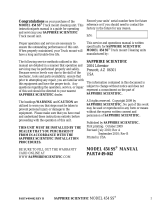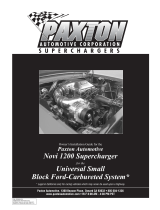Page is loading ...

1
3110 Installation Instructions
WARNING!
The fuel system is under pressure. Do not open the fuel system until the
pressure has been relieved. Refer to the appropriate vehicle service manual for
the procedure and precautions for relieving the fuel system pressure.
NOTE: Testing the enclosed regulator by applying air pressure or vacuum to the vacuum port with a hand-
held pump will yield poor results, due to the slight air leakage through the adjustment screw threads. This
minute leakage, which is typical of all adjustable fuel pressure regulators, does not, in any way, affect the
performance of the regulator.
The enclosed regulator will not necessarily seal to hold fuel pressure after the fuel pump stops running.
The enclose Aeromotive regulator utilizes one o-ring sealed AN-10 style inlet port, three o-ring
sealed AN-08 outlet ports and one o-ring sealed AN-10 style bypass; These regulator ports are
NOT PIPE THREAD and utilize NO THREAD SEALANT. The Boost reference fitting installed in the
regulator cover is a AN-04 style, if your application requires a barbed fitting one is provided for
your convenience.
The enclosed Aeromotive regulator is designed to be used with high flow, high pressure, electric
fuel pumps similar to Aeromotive’ Eliminator P/N 11104 or larger (bypass flow between 180-300
GPH). Ideal for Dual A1000 systems. Bypass restriction measures 5/16” or 0.313” on the ID.
The Vacuum / Boost reference port is provided for fuel pressure compensation on a 1:1 ratio with
manifold pressure (vacuum or boost) in PSI. This port must be connected to the intake manifold,
in the plenum (behind the throttle body) for proper vacuum/boost reference.
CAUTION:
Installation of this product requires detailed knowledge of automotive
systems and repair procedures. We recommend that this installation be carried
out by a qualified automotive technician.
Installation of this product requires handling of gasoline. Ensure you are
working in a well ventilated area with an approved fire extinguisher nearby.
Extinguish all open flames, prohibit smoking and eliminate all sources of ignition
in the area of the vehicle before proceeding with the installation.
When installing this product, wear eye goggles and other safety apparel as
needed to protect yourself from debris and sprayed gasoline.
Aeromotive system components are not legal for sale or use on emission controlled motor vehicles.

Aeromotive Commonly Used Fittings
15608 ORB-10 to AN-10 Male Flare (Inlet & bypass AN-10)
15610 ORB-10 to AN-08 Flare (Inlet fitting only AN-08)
15609 ORB-10 to AN-06 Flare (Inlet fitting only AN-06)
15642 ORB-10 to AN-12 Flare (Inlet & bypass AN-12)
** 15619 1/16” NPT to AN-04 Vac/Boost port adapter
** 15630 1/16” NPT to 5/32” Barb Vac/Boost port adapter
15662 1/16” NPT to Bronze Filter/Breather
** Included with Regulator
Aeromotive Regulator Specifications
2x ORB-10 Inlet/Outlet Ports
1x ORB-10 By-pass Ports
1x 1/16” NPT Vacuum/Boost Port
1 ea. 5/32” Hose barb and AN-04 Vacuum/Boost Adapters
0.313“ (5/16-inch) Diameter Bypass Restriction
Spring #1 30-75 psi (Factory installed in regulator)
Spring #2 75-120 psi
The following steps are typical of most installations:
1. Once the engine has been allowed to cool, disconnect the negative battery cable and relieve any fuel
system pressure.
2. Place shop towels around the regulator to catch any gasoline that is spilled during this step of the
installation. Remove any regulator mounting hardware and connecting fuel lines, then carefully
remove the regulator.
3. Find a suitable place in the vehicle’s engine compartment to mount the Aeromotive regulator. Using
the supplied mounting bracket as a template, mark the bracket mounting holes and drill to accept a
#10 screw.
4. With the bracket attached to the regulator, mount the bracket and regulator to the vehicle using two
#10 screws, nuts and lock washers.
5. Using a Y-block, split the supply line into two AN-08 lines and feed one side of each fuel rail. From the
other end of each fuel rail run an AN-08 line into each of the AN-08 ports on the regulator using the
two supplied AN-08 fittings and o-rings.
6. Using the AN-08 port plug and o-ring provided, block off the unused AN-08 port on the regulator.
7. Using the AN-10 port plug and o-ring provided, block off the AN-10 port on the front of the regulator.

AEROMOTIVE, INC.
8. Attach the fuel return line to the AN-10 bypass port located at the bottom of the regulator using the
supplied cutoff AN-10 style fitting and o-ring.
9. Tighten all connections.
10. Once the regulator is installed, attach a suitable fuel pressure gauge to the 1/8 NPT port on the fuel
pressure regulator (0-100psi 1.5" fuel pressure gauge, part # 15633). Requires thread sealant.
11. Ensure that any spilled gasoline and any gasoline soaked shop towels are cleaned up and
removed from the vicinity of the vehicle!
12. Reconnect the battery and turn the fuel pump ON WITHOUT starting the car. After several seconds,
check the fuel pressure. If there is no fuel pressure, turn the fuel pump OFF, wait one minute, return
the fuel pump ON, and recheck the fuel pressure. Repeat this OFF and ON procedure until the fuel
pressure gauge registers fuel pressure.
13. With the fuel pressure gauge registering fuel system pressure, check for fuel leaks from and
around the Aeromotive regulator and all fuel lines and connections near the regulator! If any
fuel leaks are found, turn the fuel pump OFF, remove any spilled fuel and repair the leak before
proceeding!
14. Once the fuel pressure gauge registers fuel system pressure and there are no fuel leaks, start the
engine and adjust the regulator to the desired fuel pressure. Turning the adjustment screw clockwise
will increase fuel pressure. OEM regulators are typically set at approximately 43 psi, without the
vacuum line attached. The fuel pressure adjustment range for the enclosed regulator is
30-75 psi with the factory installed spring and 75-120 with the optional spring
installed.
15. Once the desired fuel pressure is achieved, tighten the jam-nut on the adjusting stud and attach the
vacuum/boost line if the vehicle has one. The vacuum/boost port may be left open to atmosphere by
using a breather, (part #15662). Blocking the vacuum port will yield poor regulator performance. This
regulator includes vacuum/boost fittings for both AN-04 and 5/32” hose barb. Replacement fittings
can be purchased under p/n 15619 for AN-04, or p/n 15630 for 5/32” hose barb.
16. If you wish to remove the fuel pressure gauge from the vehicle, FIRST relieve the fuel system
pressure as instructed in the appropriate vehicle service manual, then remove the fuel pressure gauge
and reinstall the 1/8-NPT port plug.
17. Test drive the car to insure proper operation and re-check the fuel system for leaks. If any leaks are
found, immediately shut off the engine and repair the leak(s)!
ORB-10
Bypass/Return Port
/













